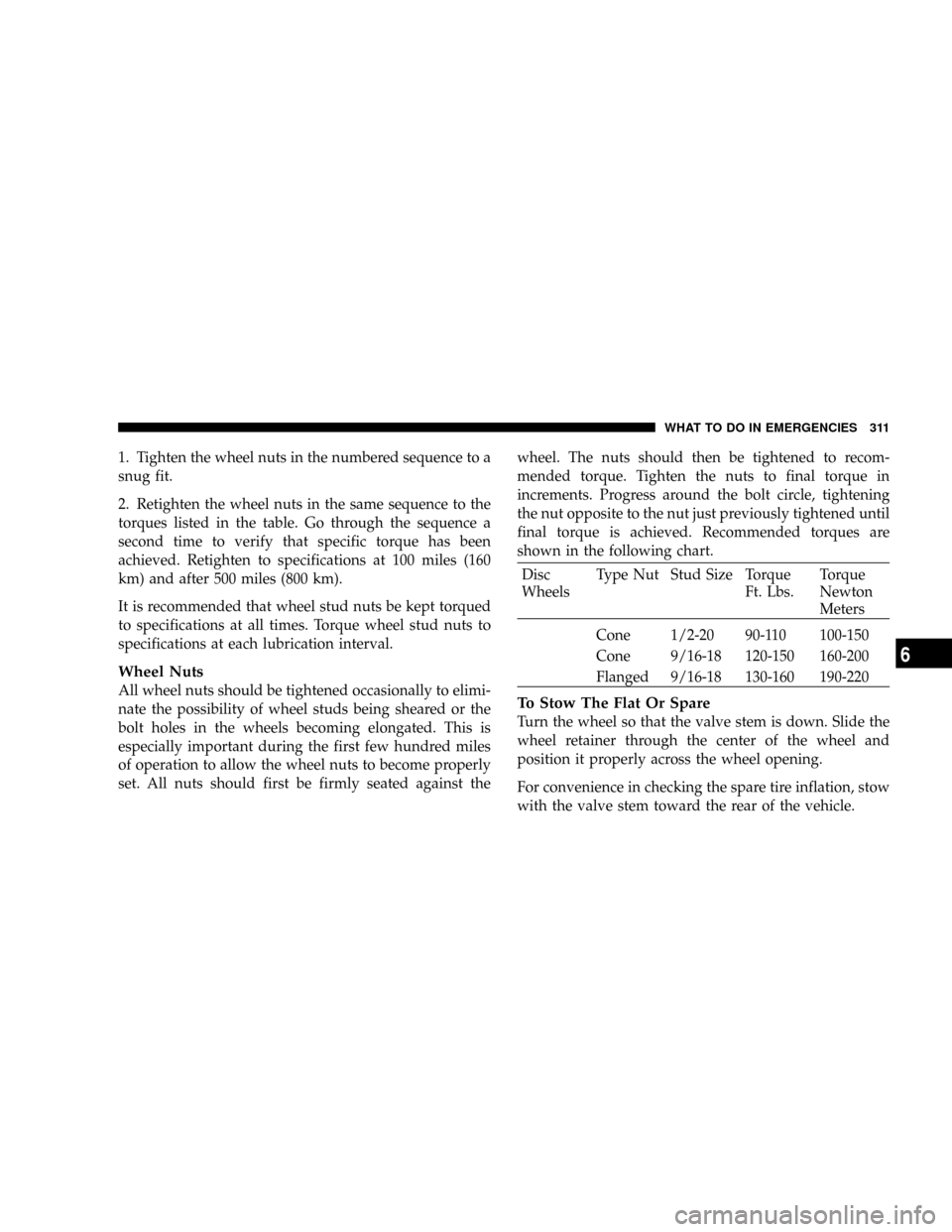Page 293 of 429
WHAT TO DO IN EMERGENCIES
CONTENTS
mHazard Warning Lights..................294
mAdding Fuel..........................295
mJack Location..........................296
NRemoval (All Models)..................296
NReinstalling The Scissors-Type Jack And Tools
(1500 Models)........................298
mChanging A Flat Tire....................301
NRemoving The Spare Tire................301
NTire Changing Procedure................302mHoisting.............................312
mJump-Starting.........................312
mFreeing A Stuck Vehicle..................316
mEmergency Tow Hooks Ð If Equipped........316
mTowing A Disabled Vehicle................317
N4-Wheel- Drive Vehicles.................317
N2±Wheel- Drive Vehicles................317
6
Page 311 of 429

1. Tighten the wheel nuts in the numbered sequence to a
snug fit.
2. Retighten the wheel nuts in the same sequence to the
torques listed in the table. Go through the sequence a
second time to verify that specific torque has been
achieved. Retighten to specifications at 100 miles (160
km) and after 500 miles (800 km).
It is recommended that wheel stud nuts be kept torqued
to specifications at all times. Torque wheel stud nuts to
specifications at each lubrication interval.
Wheel Nuts
All wheel nuts should be tightened occasionally to elimi-
nate the possibility of wheel studs being sheared or the
bolt holes in the wheels becoming elongated. This is
especially important during the first few hundred miles
of operation to allow the wheel nuts to become properly
set. All nuts should first be firmly seated against thewheel. The nuts should then be tightened to recom-
mended torque. Tighten the nuts to final torque in
increments. Progress around the bolt circle, tightening
the nut opposite to the nut just previously tightened until
final torque is achieved. Recommended torques are
shown in the following chart.
Disc
WheelsType Nut Stud Size Torque
Ft. Lbs.Torque
Newton
Meters
Cone 1/2-20 90-110 100-150
Cone 9/16-18 120-150 160-200
Flanged 9/16-18 130-160 190-220
To Stow The Flat Or Spare
Turn the wheel so that the valve stem is down. Slide the
wheel retainer through the center of the wheel and
position it properly across the wheel opening.
For convenience in checking the spare tire inflation, stow
with the valve stem toward the rear of the vehicle.
WHAT TO DO IN EMERGENCIES 311
6
Page 312 of 429

Attach the wheel wrench to the extension tube. Rotate the
winch mechanism until the wheel is drawn into place
against the underside of the vehicle. Continue to rotate
until you feel the winch mechanism slip or click 3 or 4
times. It cannot be overtightened. Push against the tire
several times to be sure it is firmly in place.
HOISTING
A conventional floor jack may be used at the jacking
locations, refer to the graphics that show jacking loca-
tions. However, a floor jack or frame hoist must never be
used on any other parts or the underbody.
CAUTION!
Never use a floor jack directly under the differential
housing of a loaded truck or damage to your vehicle
may result.
JUMP-STARTING
You should not try to start your vehicle by pushing or
towing. Vehicles equipped with an automatic transmis-
sion cannot be started this way and pushing or towing a
vehicle equipped with a manual transmission may over-
heat and damage the catalytic converter. Also, there is a
greater risk of an accident when a vehicle is being pushed
or towed. If the vehicle has a discharged battery, booster
cables may be used to obtain a start from a booster
battery or the battery in another vehicle. This type of start
can be dangerous if done improperly, so follow this
procedure carefully.
312 WHAT TO DO IN EMERGENCIES
Page 333 of 429

governmental agency for advice on how and where used
oil and oil filters can be safely discarded in your area.
Engine Oil Filter
The engine oil filter should be replaced at every engine
oil change.
Engine Oil Filter Selection
The manufacturer's engines have a full-flow type oil
filter. Use a filter of this type for replacement. The quality
of replacement filters varies considerably. Only high
quality filters should be used to assure most efficient
service. Mopar Engine Oil Filters are a high quality oil
filter and are recommended.
Drive Belts Ð Check Condition and Tensioner
Belt tension is controlled by means of an automatic
tensioner. No belt tension adjustments are required.
However, belt and belt tensioner condition should be
inspected at the specified intervals and replaced if re-
quired. See your authorized dealer for service.At the mileage indicated in the maintenance schedule, all
belts and tensioner should be checked for condition.
Improper belt tension can cause belt slippage and failure.
Belts should be inspected for evidence of cuts, cracks,
glazing or frayed cords and replaced if there is indication
of damage which could result in belt failure. Low gen-
erator belt tension can cause battery failure.
Also check belt routing to make sure there is no interfer-
ence between the belts and other engine components.
Spark Plugs
Spark plugs must fire properly to assure engine perfor-
mance and emission control. New plugs should be in-
stalled at the specified mileage. The entire set should be
replaced if there is any malfunction due to a faulty spark
plug, malfunctioning spark plugs can damage the cata-
lytic converter. For proper type of replacement spark
plugs, refer to the ªVehicle Emission Control Informa-
tionº label in the engine compartment.
MAINTAINING YOUR VEHICLE 333
7
Page 414 of 429

Adding Fuel........................259,295
Air Cleaner, Engine...................334,357
Air Conditioner Maintenance............327,338
Air Conditioning Refrigerant.......327,328,338,339
Air Conditioning System.............187,327,338
Air Conditioning System, Zone Control........ 191
Air Pressure, Tires....................244,251
Airbag..............................45,50
Airbag Light.........................70,144
Airbag On/Off Switch..................... 50
Airbag, Side............................ 53
Alarm..............................29,147
Alignment and Balance................... 250
Alterations/Modifications, Vehicle............. 7
Antifreeze (Engine Coolant)..............346,379
Anti-Lock Brake System................... 231
Anti-Lock Warning Light...............148,232
Anti-Theft System.....................29,147
Appearance Care........................ 361Ashtray............................... 127
Automatic Transmission
Adding Fluid......................... 353
Fluid and Filter Changes................. 355
Fluid Level Check...................... 352
Fluid Type........................354,382
Shift Indicator........................ 147
Shifting............................. 208
Special Additives...................... 355
Axle Fluid.......................272,350,382
Axle Lubrication.....................272,350
Ball Joints............................. 340
Battery............................... 337
Emergency Starting..................... 312
Bearings.............................. 355
Belts, Drive............................ 333
Belts, Seat.............................. 34
Body Mechanism Lubrication............... 341
414 INDEX